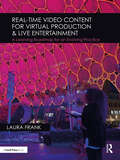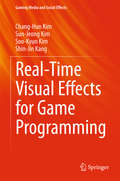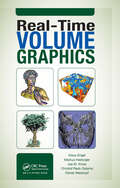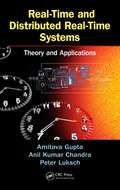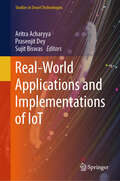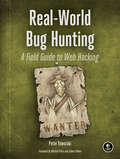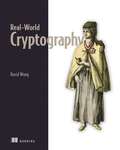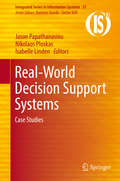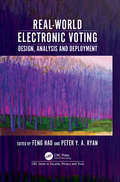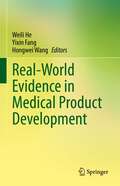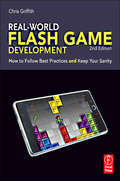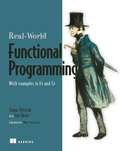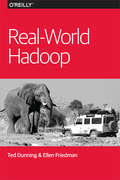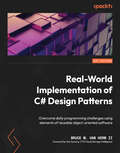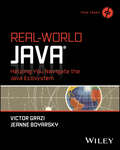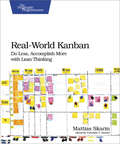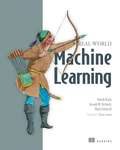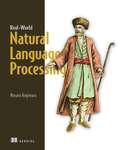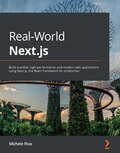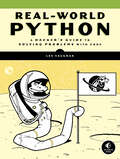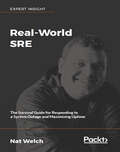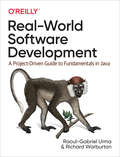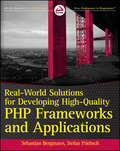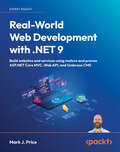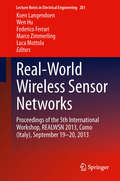- Table View
- List View
Real-Time Video Content for Virtual Production & Live Entertainment: A Learning Roadmap for an Evolving Practice
by Laura FrankReal-Time Video Content for Virtual Production & Live Entertainment looks at the evolution of current software and hardware, how these tools are used, and how to plan for productions dependent on real-time content. From rock concerts to theatre, live television broadcast to film production, art installations to immersive experiences, the book outlines the various applications of real-time video content – the intersection of gaming and performance that is revolutionizing how films are made and how video content is created for screens. Rather than render out a fixed video file, new tools allow for interactive video content that responds to audience activity, camera position, and performer action in real time. Combining software renderers with environmental information, video content is generated nearly instantaneously to simulate depth, creating a new world of Virtual Production. This book provides an overview of the current software and hardware used to create real-time content while also reviewing the various external technologies the real-time content is dependent upon. Case studies from industry experts appear in each chapter to reinforce the tools described, establish industry practice, and provide insight on a complex and rapidly growing discipline. Real-Time Video Content for Virtual Production & Live Entertainment prepares students and practitioners for a future working with real-time technologies and informs current entertainment technology professionals how to rethink about their old roles using these new tools. The book includes access to a companion website featuring web-based and video resources that expand on topics covered in the text. Each chapter has a unique page that points to example material, video presentations, and professional studies on chapter topics. You can visit the companion website at rtv-book.com.
Real-Time Visual Effects for Game Programming
by Chang-Hun Kim Sun-Jeong Kim Soo-Kyun Kim Shin-Jin KangThis book introduces the latest visual effects (VFX) techniques that can be applied to game programming. The usefulness of the physicality-based VFX techniques, such as water, fire, smoke, and wind, has been proven through active involvement and utilization in movies and images. However, they have yet to be extensively applied in the game industry, due to the high technical barriers. Readers of this book can learn not only the theories about the latest VFX techniques, but also the methodology of game programming, step by step. The practical VFX processing techniques introduced in this book will provide very helpful information to game programmers. Due to the lack of instructional books about VFX-related game programming, the demand for knowledge regarding these high-tech VFXs might be very high.
Real-Time Volume Graphics
by Klaus Engel Markus Hadwiger Joe Kniss Christof Rezk-Salama Daniel WeiskopfBased on course notes of SIGGRAPH course teaching techniques for real-time rendering of volumetric data and effects; covers both applications in scientific visualization and real-time rendering. Starts with the basics (texture-based ray casting) and then improves and expands the algorithms incrementally. Book includes source code, algorithms, diagr
Real-Time and Distributed Real-Time Systems: Theory and Applications
by Amitava Gupta Anil Kumar Chandra Peter LukschDigital computers have revolutionized computation and transformed how computers are used to control systems in real life, giving birth to real-time systems. Furthermore, massive developments in the communications domain have made it possible for real-time systems to perform coordinated actions over communication interfaces, resulting in the evoluti
Real-World Applications and Implementations of IoT (Studies in Smart Technologies)
by Aritra Acharyya Prasenjit Dey Sujit BiswasThis book explores state-of-the-art internet of things (IoT) solutions for energy conservation, security, agricultural advancements, mining security, healthcare, and environmental protection. This book delves deep into the technology, offering a comprehensive analysis, detailed descriptions, and in-depth discussions of recently developed IoT applications. With a strong focus on the cutting-edge research at a global scale, the book combines IoT with artificial intelligence (AI), shedding light on emerging possibilities and advancements. Designed to cater to a broad audience, from those with a foundational understanding of science to seasoned engineering and technology experts, this book can serve as an essential resource for engineering students and science master's programs. Researchers seeking to stay at the forefront of IoT and AI will also find it invaluable.
Real-World Bug Hunting: A Field Guide to Web Hacking
by Peter YaworskiLearn how people break websites and how you can, too. Real-World Bug Hunting is the premier field guide to finding software bugs. Whether you're a cyber-security beginner who wants to make the internet safer or a seasoned developer who wants to write secure code, ethical hacker Peter Yaworski will show you how it's done. You'll learn about the most common types of bugs like cross-site scripting, insecure direct object references, and server-side request forgery. Using real-life case studies of rewarded vulnerabilities from applications like Twitter, Facebook, Google, and Uber, you'll see how hackers manage to invoke race conditions while transferring money, use URL parameter to cause users to like unintended tweets, and more.Each chapter introduces a vulnerability type accompanied by a series of actual reported bug bounties. The book's collection of tales from the field will teach you how attackers trick users into giving away their sensitive information and how sites may reveal their vulnerabilities to savvy users. You'll even learn how you could turn your challenging new hobby into a successful career. You'll learn:How the internet works and basic web hacking conceptsHow attackers compromise websitesHow to identify functionality commonly associated with vulnerabilitiesHow to find bug bounty programs and submit effective vulnerability reportsReal-World Bug Hunting is a fascinating soup-to-nuts primer on web security vulnerabilities, filled with stories from the trenches and practical wisdom. With your new understanding of site security and weaknesses, you can help make the web a safer place--and profit while you're at it.
Real-World Cryptography
by David Wong"A staggeringly comprehensive review of the state of modern cryptography. Essential for anyone getting up to speed in information security." - Thomas Doylend, Green Rocket Security An all-practical guide to the cryptography behind common tools and protocols that will help you make excellent security choices for your systems and applications.In Real-World Cryptography, you will find: Best practices for using cryptography Diagrams and explanations of cryptographic algorithms Implementing digital signatures and zero-knowledge proofs Specialized hardware for attacks and highly adversarial environments Identifying and fixing bad practices Choosing the right cryptographic tool for any problem Real-World Cryptography reveals the cryptographic techniques that drive the security of web APIs, registering and logging in users, and even the blockchain. You&’ll learn how these techniques power modern security, and how to apply them to your own projects. Alongside modern methods, the book also anticipates the future of cryptography, diving into emerging and cutting-edge advances such as cryptocurrencies, and post-quantum cryptography. All techniques are fully illustrated with diagrams and examples so you can easily see how to put them into practice. Purchase of the print book includes a free eBook in PDF, Kindle, and ePub formats from Manning Publications. About the technology Cryptography is the essential foundation of IT security. To stay ahead of the bad actors attacking your systems, you need to understand the tools, frameworks, and protocols that protect your networks and applications. This book introduces authentication, encryption, signatures, secret-keeping, and other cryptography concepts in plain language and beautiful illustrations. About the book Real-World Cryptography teaches practical techniques for day-to-day work as a developer, sysadmin, or security practitioner. There&’s no complex math or jargon: Modern cryptography methods are explored through clever graphics and real-world use cases. You&’ll learn building blocks like hash functions and signatures; cryptographic protocols like HTTPS and secure messaging; and cutting-edge advances like post-quantum cryptography and cryptocurrencies. This book is a joy to read—and it might just save your bacon the next time you&’re targeted by an adversary after your data. What's inside Implementing digital signatures and zero-knowledge proofs Specialized hardware for attacks and highly adversarial environments Identifying and fixing bad practices Choosing the right cryptographic tool for any problem About the reader For cryptography beginners with no previous experience in the field. About the author David Wong is a cryptography engineer. He is an active contributor to internet standards including Transport Layer Security. Table of Contents PART 1 PRIMITIVES: THE INGREDIENTS OF CRYPTOGRAPHY 1 Introduction 2 Hash functions 3 Message authentication codes 4 Authenticated encryption 5 Key exchanges 6 Asymmetric encryption and hybrid encryption 7 Signatures and zero-knowledge proofs 8 Randomness and secrets PART 2 PROTOCOLS: THE RECIPES OF CRYPTOGRAPHY 9 Secure transport 10 End-to-end encryption 11 User authentication 12 Crypto as in cryptocurrency? 13 Hardware cryptography 14 Post-quantum cryptography 15 Is this it? Next-generation cryptography 16 When and where cryptography fails
Real-World Decision Support Systems
by Jason Papathanasiou Isabelle Linden Nikolaos PloskasThis book presents real-world decision support systems, i. e. , systems that have been running for some time and as such have been tested in real environments and complex situations; the cases are from various application domains and highlight the best practices in each stage of the system's life cycle, from the initial requirements analysis and design phases to the final stages of the project. Each chapter provides decision-makers with recommendations and insights into lessons learned so that failures can be avoided and successes repeated. For this reason unsuccessful cases, which at some point of their life cycle were deemed as failures for one reason or another, are also included. All decision support systems are presented in a constructive, coherent and deductive manner to enhance the learning effect. It complements the many works that focus on theoretical aspects or individual module design and development by offering 'good' and 'bad' practices when developing and using decision support systems. Combining high-quality research with real-world implementations, it is of interest to researchers and professionals in industry alike.
Real-World Electronic Voting: Design, Analysis and Deployment (Series in Security, Privacy and Trust)
by FENG HAO AND PETER Y. A. RYANReal-World Electronic Voting: Design, Analysis and Deployment captures all major developments in electronic voting since 2003 in a real-world setting. It covers three broad categories: e-voting protocols, attacks reported on e-voting and new developments on the use of e-voting. This book explores recent innovations in both poll-site and remote voting systems and their application throughout the world. The requirements of elections are analysed, the available tools and technologies are described, and a variety of modern systems are presented in detail together with discussions of deployments. This is an invaluable resource for election professionals, researchers and policy makers alike. Key Features: Reviews both technical and social aspects of e-voting Covers e-voting protocols, attacks reported on e-voting and new developments on the use of e-voting Designed for government election practitioners and policy makers who want to understand the threats and opportunities in e-voting and assess its suitability for future elections
Real-World Evidence in Medical Product Development
by Weili He Hongwei Wang Yixin FangThis book provides state-of-art statistical methodologies, practical considerations from regulators and sponsors, logistics, and real use cases for practitioners for the uptake of RWE/D. Randomized clinical trials have been the gold standard for the evaluation of efficacy and safety of medical products. However, the cost, duration, practicality, and limited generalizability have incentivized many to look for alternative ways to optimize drug development. This book provides a comprehensive list of topics together to include all aspects with the uptake of RWE/D, including, but not limited to, applications in regulatory and non-regulatory settings, causal inference methodologies, organization and infrastructure considerations, logistic challenges, and practical use cases.
Real-World Flash Game Development: How to Follow Best Practices AND Keep Your Sanity
by Christopher GriffithYour deadline just got moved up. Your artist has never worked with Flash before. Your inner programmer is telling you that no OOP is a big Oops! Any Flash developer can share similar tales of woe. This book breaks down the process of Flash game development into simple, approachable steps. Never heard of a game loop before? No idea what a design pattern is? No problem! Chris Griffith gives you real-world expertise, and real-world code that you can use in your own games. Griffith has been building games in Flash long enough to know what works and what doesn't. He shows you what you need to know to get the job done. Griffith covers Flash for the everyday developer. The average Flash developer doesn't have luxurious timelines, employers who understand the value of reusability, or the help of an information architect to design a usable experience. This book helps bridge the gap for these coders who may be used to C++, Java, or C# and want to move over to Flash. Griffith covers real-world scenarios pulled from his own experiences developing games for over 10 years in the industry. The 2nd edition will include: completely new game examples on more advanced topics like 3D; more robust physics and collision detection; and mobile device coverage with Android platform development for us on phones and tablets. Also coverage of the new features available in Flash CS5, Flash Player 10.1, and AIR 2.0 that can be used for game development.The associated web site for the book: www.flashgamebook.com gets close to 1,000 visits a month. On the site, readers can find all the source code for the examples, news on industry happenings, updates and special offers, and a discussion forum to ask questions and share ideas.
Real-World Functional Programming: With examples in F# and C#
by Tomas Petricek Jonathan SkeetFunctional programming languages like F#, Erlang, and Scala are attractingattention as an efficient way to handle the new requirements for programmingmulti-processor and high-availability applications. Microsoft's new F# is a truefunctional language and C# uses functional language features for LINQ andother recent advances.Real-World Functional Programming is a unique tutorial that explores thefunctional programming model through the F# and C# languages. The clearlypresented ideas and examples teach readers how functional programming differsfrom other approaches. It explains how ideas look in F#-a functionallanguage-as well as how they can be successfully used to solve programmingproblems in C#. Readers build on what they know about .NET and learn wherea functional approach makes the most sense and how to apply it effectively inthose cases.The reader should have a good working knowledge of C#. No prior exposure toF# or functional programming is required. Purchase of the print book comes with an offer of a free PDF, ePub, and Kindle eBook from Manning. Also available is all code from the book.
Real-World Hadoop
by Ellen Friedman Ted DunningIf you’re a business team leader, CIO, business analyst, or developer interested in how Apache Hadoop and Apache HBase-related technologies can address problems involving large-scale data in cost-effective ways, this book is for you. Using real-world stories and situations, authors Ted Dunning and Ellen Friedman show Hadoop newcomers and seasoned users alike how NoSQL databases and Hadoop can solve a variety of business and research issues.You’ll learn about early decisions and pre-planning that can make the process easier and more productive. If you’re already using these technologies, you’ll discover ways to gain the full range of benefits possible with Hadoop. While you don’t need a deep technical background to get started, this book does provide expert guidance to help managers, architects, and practitioners succeed with their Hadoop projects.Examine a day in the life of big data: India’s ambitious Aadhaar projectReview tools in the Hadoop ecosystem such as Apache’s Spark, Storm, and Drill to learn how they can help youPick up a collection of technical and strategic tips that have helped others succeed with HadoopLearn from several prototypical Hadoop use cases, based on how organizations have actually applied the technologyExplore real-world stories that reveal how MapR customers combine use cases when putting Hadoop and NoSQL to work, including in production
Real-World Implementation of C# Design Patterns: Overcome daily programming challenges using elements of reusable object-oriented software
by Bruce M. Van Horn II Van SymonsBuild robust applications in C# easily using effective and popular design patterns and best practicesKey FeaturesRecognize solutions to common problems in software design with C#Explore real-world applications of design patterns that can be used in your everyday workGet to grips with 14 patterns and their design implementationsBook DescriptionAs a software developer, you need to learn new languages and simultaneously get familiarized with the programming paradigms and methods of leveraging patterns, as both a communications tool and an advantage when designing well-written, easy-to-maintain code. Design patterns, being a collection of best practices, provide the necessary wisdom to help you overcome common sets of challenges in object-oriented design and programming.This practical guide to design patterns helps C# developers put their programming knowledge to work. The book takes a hands-on approach to introducing patterns and anti-patterns, elaborating on 14 patterns along with their real-world implementations. Throughout the book, you'll understand the implementation of each pattern, as well as find out how to successfully implement those patterns in C# code within the context of a real-world project.By the end of this design patterns book, you'll be able to recognize situations that tempt you to reinvent the wheel, and quickly avoid the time and cost associated with solving common and well-understood problems with battle-tested design patterns.What you will learnGet to grips with patterns, and discover how to conceive and document themExplore common patterns that may come up in your everyday workRecognize common anti-patterns early in the processUse creational patterns to create flexible and robust object structuresEnhance class designs with structural patternsSimplify object interaction and behavior with behavioral patternsWho this book is forThis book is for beginner and mid-level software developers who are looking to take their object-oriented programs or software designing skills to the next level by learning to leverage common patterns. A firm grasp of programming fundamentals and classical object-oriented programming (OOP) using languages like C#, C++, Objective-C, or Java is expected.
Real-World Java: Helping You Navigate the Java Ecosystem (Tech Today)
by Jeanne Boyarsky Victor GraziA concise handbook for the most common tools used in modern Java development Good Java developers learn Java syntax, how to create loops and switches, and can work out a lambda filter stream. But great Java developers need to understand the vast ecosystem of tools and frameworks for collaboration, testing, building, and more. In Real-World Java®: Helping You Navigate the Java Ecosystem, a team of veteran Java developers delivers a concise and authoritative discussion of the most common frameworks, tools, and techniques used in enterprise Java development shops. The authors provide just enough background and examples to allow you to dive right into the expert guidance on annotations, logging frameworks, observability, performance tuning, testing tools, and collaboration, that real-life commercial Java development typically relies on. You’ll expand your Java development toolkit with frameworks and utilities like Spring, Git, Prometheus, and Project Lombok. You’ll also discover links to tested, downloadable code examples that demonstrate the skills discussed in the book. Real-World Java® is the perfect resource for everyone already somewhat comfortable with the language but who wants to familiarize themselves with the tools and frameworks used in contemporary Java software development.
Real-World Kanban: Do Less, Accomplish More with Lean Thinking
by Mattias SkarinYour team is stressed; priorities are unclear. You're not sure what your teammates are working on, and management isn't helping. If your team is struggling with any of these symptoms, these four case studies will guide you to project success. See how Kanban was used to significantly improve time to market and to create a shared focus across marketing, IT, and operations. Each case study comes with illustrations of the Kanban board and diagrams and graphs to help you see behind the scenes.Learn a Lean approach by seeing how Kanban made a difference in four real-world situations. You'll explore how four different teams used Kanban to make paradigm-changing improvements in software development. These teams were struggling with overwork, unclear priorities, and lack of direction. As you discover what worked for them, you'll understand how to make significant changes in real situations.The four case studies in this book explain how to: Improve the full value chain by using Enterprise Kanban Boost engagement, teamwork, and flow in change management and operations Save a derailing project with Kanban Help an office team outside IT keep up with growth using KanbanWhat seems easy in theory can become tangled in practice. Discover why "improving IT" can make you miss your biggest improvement opportunities, and why you should focus on fixing quality and front-end operations before IT. Discover how to keep long-term focus and improve across department borders while dealing with everyday challenges. Find out what happened when using Kanban to find better ways to do work in a well-established company, including running multi-team development without a project office. You'll inspire your team and engage management to make it easier to develop better products.What You Need:This is a case study book, so there are no software requirements. The book covers the relevant bits of theory before presenting the case studies.
Real-World Machine Learning
by Henrik Brink Joseph Richards Mark FetherolfSummary Real-World Machine Learning is a practical guide designed to teach working developers the art of ML project execution. Without overdosing you on academic theory and complex mathematics, it introduces the day-to-day practice of machine learning, preparing you to successfully build and deploy powerful ML systems. Purchase of the print book includes a free eBook in PDF, Kindle, and ePub formats from Manning Publications. About the Technology Machine learning systems help you find valuable insights and patterns in data, which you'd never recognize with traditional methods. In the real world, ML techniques give you a way to identify trends, forecast behavior, and make fact-based recommendations. It's a hot and growing field, and up-to-speed ML developers are in demand. About the Book Real-World Machine Learning will teach you the concepts and techniques you need to be a successful machine learning practitioner without overdosing you on abstract theory and complex mathematics. By working through immediately relevant examples in Python, you'll build skills in data acquisition and modeling, classification, and regression. You'll also explore the most important tasks like model validation, optimization, scalability, and real-time streaming. When you're done, you'll be ready to successfully build, deploy, and maintain your own powerful ML systems. What's Inside Predicting future behavior Performance evaluation and optimization Analyzing sentiment and making recommendations About the Reader No prior machine learning experience assumed. Readers should know Python. About the Authors Henrik Brink, Joseph Richards and Mark Fetherolf are experienced data scientists engaged in the daily practice of machine learning. Table of Contents PART 1: THE MACHINE-LEARNING WORKFLOW What is machine learning? Real-world data Modeling and prediction Model evaluation and optimization Basic feature engineering PART 2: PRACTICAL APPLICATION Example: NYC taxi data Advanced feature engineering Advanced NLP example: movie review sentiment Scaling machine-learning workflows Example: digital display advertising
Real-World Natural Language Processing: Practical applications with deep learning
by Masato HagiwaraReal-world Natural Language Processing shows you how to build the practical NLP applications that are transforming the way humans and computers work together.In Real-world Natural Language Processing you will learn how to: Design, develop, and deploy useful NLP applications Create named entity taggers Build machine translation systems Construct language generation systems and chatbots Use advanced NLP concepts such as attention and transfer learning Real-world Natural Language Processing teaches you how to create practical NLP applications without getting bogged down in complex language theory and the mathematics of deep learning. In this engaging book, you&’ll explore the core tools and techniques required to build a huge range of powerful NLP apps, including chatbots, language detectors, and text classifiers. Purchase of the print book includes a free eBook in PDF, Kindle, and ePub formats from Manning Publications. About the technology Training computers to interpret and generate speech and text is a monumental challenge, and the payoff for reducing labor and improving human/computer interaction is huge! Th e field of Natural Language Processing (NLP) is advancing rapidly, with countless new tools and practices. This unique book offers an innovative collection of NLP techniques with applications in machine translation, voice assistants, text generation, and more. About the book Real-world Natural Language Processing shows you how to build the practical NLP applications that are transforming the way humans and computers work together. Guided by clear explanations of each core NLP topic, you&’ll create many interesting applications including a sentiment analyzer and a chatbot. Along the way, you&’ll use Python and open source libraries like AllenNLP and HuggingFace Transformers to speed up your development process. What's inside Design, develop, and deploy useful NLP applications Create named entity taggers Build machine translation systems Construct language generation systems and chatbots About the reader For Python programmers. No prior machine learning knowledge assumed. About the author Masato Hagiwara received his computer science PhD from Nagoya University in 2009. He has interned at Google and Microsoft Research, and worked at Duolingo as a Senior Machine Learning Engineer. He now runs his own research and consulting company. Table of Contents PART 1 BASICS 1 Introduction to natural language processing 2 Your first NLP application 3 Word and document embeddings 4 Sentence classification 5 Sequential labeling and language modeling PART 2 ADVANCED MODELS 6 Sequence-to-sequence models 7 Convolutional neural networks 8 Attention and Transformer 9 Transfer learning with pretrained language models PART 3 PUTTING INTO PRODUCTION 10 Best practices in developing NLP applications 11 Deploying and serving NLP applications
Real-World Next.js: Build scalable, high-performance, and modern web applications using Next.js, the React framework for production
by Michele RivaLearn how to use Next.js for building web apps without compromising performance, user experience, and developer happinessKey FeaturesDevelop scalable web applications using Next.jsUse Next.js as a frontend for existing backends and e-commerce websites and understand how to implement it with any headless CMSDeploy Next.js on different platforms, such as Vercel, DigitalOcean, and AWS, or on your own serverBook DescriptionNext.js is a scalable and high-performance React.js framework for modern web development and provides a large set of features, such as hybrid rendering, route prefetching, automatic image optimization, and internationalization, out of the box. If you are looking to create a blog, an e-commerce website, or a simple website, this book will show you how you can use the multipurpose Next.js framework to create an impressive user experience.Starting with the basics of Next.js, the book demonstrates how the framework can help you reach your development goals. You'll realize how versatile Next.js is as you build real-world applications with step-by-step explanations. This Next.js book will guide you in choosing the right rendering methodology for your website, securing it, and deploying it to different providers, all while focusing on performance and developer happiness.By the end of the book, you'll be able to design, build, and deploy modern architectures using Next.js with any headless CMS or data source.What you will learnGet up to speed with Next.js essentials and learn how to build apps quicklyUnderstand how to create scalable Next.js architecturesChoose between different rendering strategies, such as client-side rendering (CSR), static site generation (SSG), server-side rendering (SSR), and incremental static regeneration (ISR)Write unit tests and integration tests in your Next.js applicationDiscover the powerful routing system and Next.js' built-in componentsDesign and build modern architectures with Next.js using GraphCMS or any headless CMSWho this book is forThis book is for web developers who want to improve their React skills by building scalable and maintainable full-stack applications using the modern Next.js web framework. Intermediate-level knowledge of ES6+, React, Node.js, and REST is assumed.
Real-World Python: A Hacker's Guide to Solving Problems with Code
by Lee VaughanA project-based approach to learning Python programming for beginners. Intriguing projects teach you how to tackle challenging problems with code.You've mastered the basics. Now you're ready to explore some of Python's more powerful tools. Real-World Python will show you how.Through a series of hands-on projects, you'll investigate and solve real-world problems using sophisticated computer vision, machine learning, data analysis, and language processing tools. You'll be introduced to important modules like OpenCV, NumPy, Pandas, NLTK, Bokeh, Beautiful Soup, Requests, HoloViews, Tkinter, turtle, matplotlib, and more. You'll create complete, working programs and think through intriguing projects that show you how to:Save shipwrecked sailors with an algorithm designed to prove the existence of GodDetect asteroids and comets moving against a starfieldProgram a sentry gun to shoot your enemies and spare your friendsSelect landing sites for a Mars probe using real NASA mapsSend unbreakable messages based on a book codeSurvive a zombie outbreak using data scienceDiscover exoplanets and alien megastructures orbiting distant starsTest the hypothesis that we're all living in a computer simulationAnd more!If you're tired of learning the bare essentials of Python Programming with isolated snippets of code, you'll relish the relevant and geeky fun of Real-World Python!
Real-World SRE: The Survival Guide for Responding to a System Outage and Maximizing Uptime
by Nat WelchThis hands-on survival manual will give you the tools to confidently prepare for and respond to a system outage. Key Features Proven methods for keeping your website running A survival guide for incident response Written by an ex-Google SRE expert Book Description Real-World SRE is the go-to survival guide for the software developer in the middle of catastrophic website failure. Site Reliability Engineering (SRE) has emerged on the frontline as businesses strive to maximize uptime. This book is a step-by-step framework to follow when your website is down and the countdown is on to fix it. Nat Welch has battle-hardened experience in reliability engineering at some of the biggest outage-sensitive companies on the internet. Arm yourself with his tried-and-tested methods for monitoring modern web services, setting up alerts, and evaluating your incident response. Real-World SRE goes beyond just reacting to disaster—uncover the tools and strategies needed to safely test and release software, plan for long-term growth, and foresee future bottlenecks. Real-World SRE gives you the capability to set up your own robust plan of action to see you through a company-wide website crisis. The final chapter of Real-World SRE is dedicated to acing SRE interviews, either in getting a first job or a valued promotion. What you will learn Monitor for approaching catastrophic failure Alert your team to an outage emergency Dissect your incident response strategies Test automation tools and build your own software Predict bottlenecks and fight for user experience Eliminate the competition in an SRE interview Who this book is for Real-World SRE is aimed at software developers facing a website crisis, or who want to improve the reliability of their company's software. Newcomers to Site Reliability Engineering looking to succeed at interview will also find this invaluable.
Real-World Software Development: A Project-Driven Guide to Fundamentals in Java
by Richard Warburton Raoul-Gabriel UrmaExplore the latest Java-based software development techniques and methodologies through the project-based approach in this practical guide. Unlike books that use abstract examples and lots of theory, Real-World Software Development shows you how to develop several relevant projects while learning best practices along the way.With this engaging approach, junior developers capable of writing basic Java code will learn about state-of-the-art software development practices for building modern, robust and maintainable Java software. You’ll work with many different software development topics that are often excluded from software develop how-to references.Featuring real-world examples, this book teaches you techniques and methodologies for functional programming, automated testing, security, architecture, and distributed systems.
Real-World Solutions for Developing High-Quality PHP Frameworks and Applications
by Sebastian Bergmann Stefan PriebschLearn to develop high-quality applications and frameworks in PHPPacked with in-depth information and step-by-step guidance, this book escorts you through the process of creating, maintaining and extending sustainable software of high quality with PHP. World-renowned PHP experts present real-world case studies for developing high-quality applications and frameworks in PHP that can easily be adapted to changing business requirements. . They offer different approaches to solving typical development and quality assurance problems that every developer needs to know and master.Details the process for creating high-quality PHP frameworks and applications that can easily be adapted to changing business requirementsCovers the planning, execution, and automation of tests for the different layers and tiers of a Web applicationDemonstrates how to establish a successful development processShares real-world case studies from well-known companies and their PHP expertsWith this book, you'll learn to develop high-quality PHP frameworks and applications that can easily be maintained with reasonable cost and effort.
Real-World Web Development with .NET 9: Build websites and services using mature and proven ASP.NET Core MVC, Web API, and Umbraco CMS
by Mark J. PriceA practical guide for building websites and services with mature and proven ASP.NET Core controller-based technologies.Key FeaturesMaster ASP.NET Core MVC, Web API, and OData for building robust web services.Get hands-on experience with web testing, security, and containerization techniques.Learn how to implement Umbraco CMS for content management websites.Book DescriptionReal-World Web Development with .NET 9 equips you to build professional websites and services using proven technologies like ASP.NET Core MVC, Web API, and OData—trusted by organizations for delivering robust web applications. You’ll learn to design and build efficient web applications with ASP.NET Core MVC, creating well-structured, maintainable code that follows industry best practices. From there, you'll dive into Web API, mastering how to build RESTful services that are both secure and scalable. Along the way, you’ll also explore testing, authentication, containerization for deployment, ensuring that your solutions are fully production-ready. In the final part of the book, you will be introduced to Umbraco CMS, a popular content management system for .NET. By mastering this tool, you’ll learn how to empower users to manage website content independently. By the end of this book, you'll not only have a solid grasp of controller-based development but also the practical know-how to build dynamic, content-driven websites using a popular .NET CMS.What you will learnBuild web applications using ASP.NET Core MVC with well-structured, maintainable codeDevelop secure and scalable RESTful services using Web API and ODataImplement authentication and authorization for your applicationsTest and containerize your .NET projects for smooth deploymentOptimize application performance with caching and other techniquesLearn how to use and implement Umbraco CMSWho this book is forThis book is aimed at intermediate .NET developers with a good understanding of C# and .NET fundamentals. It is ideal for developers looking to expand their skills in building professional, controller-based web applications.
Real-World Wireless Sensor Networks
by Luca Mottola Koen Langendoen Wen Hu Federico Ferrari Marco ZimmerlingThis edited book presents the results of the 5th Workshop on Real-world Wireless Sensor Networks (REALWSN). The purpose of this workshop was to bring together researchers and practitioners working in the area of sensor networks, with focus on real-world experiments or deployments of wireless sensor networks. Included were, nonetheless, emerging forms of sensing such as those that leverage smart phones, Internet of Things, RFIDs, and robots. Indeed, when working with real-world experiments or deployments, many new or unforeseen issues may arise: the network environment may be composed of a variety of different technologies, leading to very heterogeneous network structures; software development for large scale networks poses new types of problems; the performance of prototype networks may differ significantly from the deployed system; whereas actual sensor network deployments may need a complex combination of autonomous and manual configuration. Furthermore, results obtained through simulation are typically not directly applicable to operational networks; it is therefore imperative for the community to produce results from experimental research. The workshop collected the state of the art in emerging and current research trends dealing with Real-world Wireless Sensor Networks, with the aim of representing a stepping stone for future research in this field.
